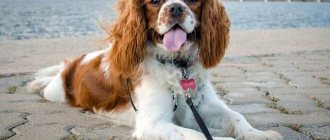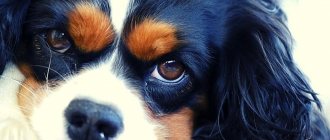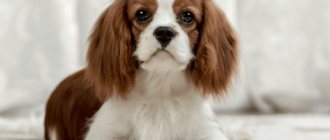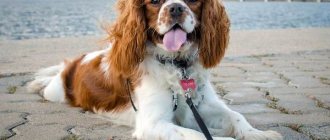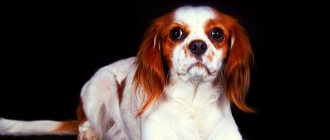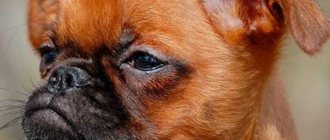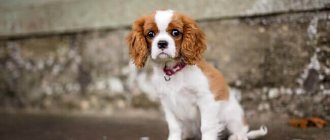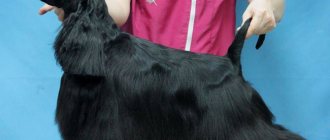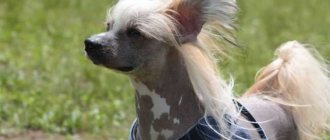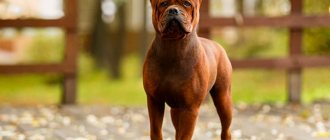Small dogs can perform not only a decorative role; some of them are distinguished by exceptional intelligence, intelligence, and useful skills. The Cavalier King Charles Spaniel is one of these pets. In addition to their intellectual abilities, they are valued for their exceptional attention to children. When there is a child in the family, you can safely have such a pet; he will take on the responsibilities of a nanny, a security guard, and a friend.
Description of the Cavalier King Charles Spaniel breed
Popularity 217th place among 263 dog breeds
Lifespan:
11-12 years old
Breed group:
Decorative
Height:
up to 32 cm
Country of origin:
Great Britain
Average price:
15-30 thousand rubles
Weight:
from 5.5 to 8 kg
Latest articles Cat health
Rabies vaccination for cats: choice of vaccine, necessity, schedule 01/22/2022 20 0 0
Selection and adaptation
TOP 20 best cat breeds for families with children 01/22/2022 33 0 0
Price
The cost of these status pets cannot be called low. In prestigious Russian nurseries their price can reach up to 55 thousand rubles. Some champion dogs are sold from 65 thousand rubles.
But, if “pedigree” is a word that doesn’t mean anything to you, we recommend saving money and buying a puppy from a private breeder. The main thing is to make sure that it is well built and looks healthy. The price of a Cavalier Charles King Spaniel from private owners is from 7 to 10 thousand rubles.
Key facts
The name of the breed is very long, but the breeders did not come up with other names, because spaniels have no use for it. The country of origin of friendly cavaliers (this is the abbreviated name of the breed) is Great Britain.
The characteristics of the Cavalier King Charles Spaniel breed say that these dogs are extroverts to the core. They have an irresistible desire to quickly get acquainted with the giant world around them, to smell and lick everything and everyone. Spaniels love to be stroked and gently brushed with a massage brush; In addition, they love to spend time with their owner, especially in his arms. A dog can achieve such intimacy in all ways known to him, most often through excessive affection. Cute nicknames will easily reflect the pet’s inner world; they will best match the description of the Cavalier King Charles Spaniel breed.
Small sizes allow you to keep gentlemen even in a small apartment. The height at the withers, that is, the height of the Cavalier King Charles Spaniel, reaches 32 cm (females are usually shorter than males). The standard weight is considered to be in the range from 5 to 8 kg (females weigh 5-6 kg, males - 6-8 kg). Non-compliance with the stated data is allowed, provided that the animal looks proportional, but a dog with miniature dimensions is more likely to win at the exhibition.
If your dog is active, eats enough and gets enough attention, this will have a positive effect on his condition. The average lifespan of a Cavalier King Charles Spaniel is 12 years; If the owners take good care of their four-legged friends, King Charles dogs live up to 15 years, which is considered quite a long time.
Acana Heritage (6 kg) (for small breeds)
This Canadian product is a good choice for a miniature breed dog. It is suitable for both active animals and completely lazy ones. The food is holistic, that is, it contains only natural ingredients.
There are no cheap low-quality components in the products of this brand; feed wheat and bone meal are completely absent. Contains only meat, fish, vegetables, fruits, and high quality dairy products.
pros
- High concentration of animal proteins;
- Fresh ingredients;
- There are no carbohydrates (the dog’s body does not need them);
- A variety of fruits, vegetables, tonic herbs in the composition, which strengthen the heart and improve the condition of the gastrointestinal tract;
- Reduces insulin levels, strengthens the liver;
- High quality packaging.
Minuses
- May cause allergies;
- Noticeable fishy smell;
- High fat content.
History of the origin of the Cavalier King Charles Spaniel
The breed's ancestors, brave miniature hunters, accompanied the Celtic people starting in the ninth century. For a long time they traveled side by side with people, but, once in England, they settled on the territory of this country. Court people, in particular the Stuart dynasty, left gentlemen at court - they played the role of decorative dogs, which they treated tenderly and reverently because of their great love for them. It was believed that the Cavalier King Charles Spaniel breed was developed by Charles II, but the monarch only encouraged breeding work. Despite this, the breed received his name.
John Churchill, Winston Churchill's ancestor, was also fond of breeding spaniels. For his great services to his homeland, the man received an estate where he could breed dogs. In addition to standard breeding, Churchill tried to introduce diversity into the breed's gene pool. The breeder managed to do this: thanks to his activities, the following types of colors appeared: Blenheim and white-pink.
The fashion for pugs, which arose in the eighteenth century, spread to Cavalier Spaniels and made them a purely decorative breed - all the working qualities of the dogs were dulled. Despite this, they remained popular among the nobility, because they proved to people that they remain faithful to their owner in any situation: during palace coups, the dogs did not abandon their owner, helping him to the end.
History of appearance
The origin story of the Cavalier Charles Spaniel goes back a long way.
It is generally accepted in the world that the creator of the breed is the king.
But the very first spaniels had a completely unroyal appearance; they were much larger and rougher. Their main purpose was to help hunters. Of course, we didn’t go hunting big game with this spaniel, but when hunting birds, the gentleman turned out to be a useful assistant and demonstrated an excellent sense of smell, complete fearlessness and mobility.
The breed was first mentioned in the 13th century. And already in the 15th century, the Charles King Spaniel reached the peak of popularity.
The birthplace of the breed is considered to be Great Britain. But exactly how these dogs originated is not known exactly. There is an assumption that tiny spaniels were brought to the country by the Celts back in the 9th century. Or the cavaliers - descendants of the Pekingese - arrived in Britain in the same 9th century, but from China.
Over time, they took a closer look at spaniels and appreciated their beautiful coat, expressive eyes, smooth lines and curves. Specialists began to work on the breed purposefully, and as a result of this work, the appearance of the dogs underwent significant changes.
The animals decreased in size, their muzzles shortened, and their noses became flattened. The new dog ceased to be a hunter, she confidently entered the royal palaces and houses of noble people as a beautiful decoration and took a strong place there. Pets looked great in living rooms, lying on sofa cushions, and were more than once captured by artists on canvases next to their eminent owners.
Animal figures were also sculpted from clay. Works of art that have survived to this day are very popular among connoisseurs.
It is known that Charles Spaniels were bred directly in palaces.
Small puppies, which could already be weaned from their mother, were given to servants. Specially trained servants trained the dogs and instilled in them good manners.
The breed got its name thanks to the monarchs, whose favorites it was.
With his master, Charles I, the spaniel was in prison for a long time. He was also present at the execution of his beloved owner. And Charles II (in English this name is both written and pronounced as Charles) by a special decree allowed these dogs to be allowed into any place.
Photo: https://pixabay.com/photos/dog-spaniel-cavalier-king-charles-634031/ After the death of the king, the popularity of spaniels began to fade, and pugs attracted the attention of the nobility. At the beginning of the 20th century, there were catastrophically few representatives of this breed left. But there were enthusiasts who managed to revive dogs. In 1928, the first breed standard for the Cavalier Charles Spaniel was developed in Great Britain.
Similar dog breeds
Pomeranian Spitz
Shih Tzu
Yorkshire Terrier
Bichon Frize
Character and behavioral characteristics
The most striking feature of the mini spaniel's character is his involvement in the family. He is everywhere and everywhere. Such a dog needs communication; if left alone at home, it literally suffers and can act out.
Gentlemen often suffer from excessive timidity and can “withdraw into themselves” if the owner allows himself to be rude. However, they love everyone around them and are not suitable for the role of a security guard. They allow themselves to bark a lot and loudly, especially from an excess of feelings.
Photo: pixabay.com
Appearance of a Cavalier King Charles Spaniel
Videos can show how beautifully the coat shimmers in the morning sun, and pictures and photos of the Cavalier King Charles Spaniel prove that this is a smart and mischievous pet.
General impression
The main thing in assessing the appearance of a Cavalier King Charles Spaniel at an exhibition is the proportionality of the height at the withers and weight, but judges can also pay attention to the compliance of the indicators with the standard. A dog may not be allowed to be bred if it does not meet certain criteria.
Head
The head is quite voluminous, the skull is not convex. The high-set ears are covered with dense hair. The stop is normally expressed. The eyes are round and set wide apart; Characteristic colors range from a mixture of brown and gold to black. The look is conscious and friendly.
The muzzle is cone-shaped, narrowing from the base to a black nose with well-developed nostrils. The developed upper lip covers the lower lip. Scissor bite.
Neck
The neck is of normal length with a slightly convex nape allowing the dog to hold its head proudly.
Torso
The somewhat stretched body has smooth, rounded shapes. The shallow chest is oval, connected by a short loin with a flat back, smoothly sloping croup.
Forelegs
Strength, proportionality of length to the body, parallelism are characteristic of the front paws. The elbow fits tightly to the chest. The rounded metatarsals gather into a ball. Claws and pads are black.
Hind limbs
Standing and looking from behind, you will notice that the spaniel's slender hind legs are parallel, not sloping, and more muscular than the front legs. The knee joint is not everted. The hock joint is normally expressed. The paws are rounded and gather into a ball. Claws and pads are black.
Tail
The tail is not docked, which is why it retains its natural length. It doesn’t matter what emotions the pet is experiencing: the tail is almost always no higher than the line of the back.
Movement
The energy and cheerfulness inherent in the “boys” and “girls” of this breed is noticeable in the animal’s fast, springy gait. The paws are moved parallel to each other.
Wool
The wool is smooth and silky. The hairs are either straight or somewhat wavy.
Color
What colors are typical for the Cavalier King Charles Spaniel?
- Blenheim - rich chestnut color of spots on milky white wool, the crown is “marked” with a white diamond;
- ruby - a rich ruby shade of wool, white spots on which are considered a defect;
- black and tan - blue-black coat with red tan marks above the eyes, on the cheekbones, inside the ears, body, tail;
- tricolor - the “background” of pearly white color is diluted with red and black spots.
Solid colors should not be disturbed by spots, inclusions and impurities of any color.
Size
The Cavalier King Charles Spaniel is quite small in size. The normal weight of a Cavalier King Charles Spaniel varies from 5.4 to 8.2 kg, height - up to 34 cm. Puppies quickly gain weight, because of this it is important to monitor their diet. An adult dog must meet the standard to participate in exhibitions, because often obese animals are not allowed to participate.
Nutritional Features
The main thing you need to know about the nutrition of King Charles Spaniels is that it should be balanced and contain all the necessary vitamins and minerals. These can be natural products or industrial feeds - the choice depends on the owner.
With natural feeding, the dog owner himself chooses the products for the dog and controls their quality. However, difficulties may arise in preparing a balanced diet, since without certain knowledge of veterinary nutrition it is impossible to do this.
The menu should include:
- lean meat (beef, veal, turkey);
- offal (tripe, lung, heart, liver);
- cereals (rice, buckwheat, oatmeal);
- vegetables and fruits;
- quail eggs;
- sea fish;
- low-fat fermented milk products (cottage cheese, yogurt, natural yogurt, kefir).
It is forbidden to feed your pet:
- fatty meat;
- river fish;
- citrus fruits;
- potatoes;
- legumes;
- spicy and fried foods;
- pickles, marinades;
- sausages, pasta and bakery products.
It is also necessary to give the dog a small amount of vegetable oils to improve the condition of the coat.
Industrial food allows you to save time on preparing food for your dog and does not require additional vitamin and mineral complexes, since their composition is enriched with all the necessary macro- and microelements.
NOTE!
When choosing food for your pet, you should take into account that it should be premium, super-premium or holistic class. Representatives of this breed are prone to allergic reactions, so the composition should not contain wheat or chicken. In addition, food must be selected taking into account the age, activity level, physiological state and health of the dog.
The most suitable diets for King Charles Spaniels are developed by the brands Probalance, Savarra, Pro Plan, Royal Canin, Go, Acana.
Personality of the Cavalier King Charles Spaniel
Who is the Cavalier King suitable for? The uniqueness of the breed lies in the fact that its representatives feel good in the company of active youth, young families, and retirees. The main thing for charming fluffies is the opportunity to be close to the owner: the dog needs mandatory tactile contact, and without an emotional connection the baby will quickly disappear. Therefore, it is important for those people who have adopted a spaniel to be aware of all the responsibilities they have regarding the psychological comfort of their four-legged friend.
Other well-known facts are the positive character traits of the Cavalier King Charles Spaniel: openness, friendliness, energy, sanguine temperament. The gentleman will play with children (especially snowball fights outside in winter), will easily share the territory entrusted to him (but not the owner with other animals), and will not hesitate to ask a stranger on the street to scratch behind the ear.
Sometimes this behavior can irritate the owner, but the only thing that can be done is to play with the pet so that it releases all its irrepressible energy. Because of this, dog experts advise either active people or large families to own dogs of this breed. The third “option” could be buying another four-legged friend.
At home, the gentleman will get bored very quickly (it doesn’t matter whether the owner lives in an apartment or in a country house). Therefore, a long walk is required. Puppies are much more restless than adults, so some corner should be created for them where they could splash out energy and explore the world around them.
Breed traits
Breed traits (on a 5-point scale)
| Cavalier King Charles Spaniel | |||
| Activity | in the house | 1.5 | |
| on the street | 2.5 | ||
| Obedience | training | 4 | |
| strangers | 3 | ||
| Domination | in family | 1.5 | |
| over dogs | 1 | ||
| Defending your territory | from people | 1 | |
| from dogs | 1 | ||
| Sociability | in family | 5 | |
| with strangers | 2 | ||
| with dogs | 3 | ||
| Concentration | in family | 1 | |
| in front of strangers | 3 | ||
| with dogs | 2 | ||
| Aggressiveness | in family | 1.5 | |
| to strangers | 1.5 | ||
| to the dogs | 1.5 | ||
| to cats | 1.5 | ||
| Family behavior | calmness | 5 | |
| demand for affection | 5 | ||
| excitability | 2.5 | ||
| playfulness | 3 | ||
| excessive barking | 1.5 | ||
| behavioral breakdowns | 1.5 | ||
| Tolerance for children | up to 4 years | 3 | |
| over 4 years old | 4 | ||
| Institutional use | watchman | 2 | |
| bodyguard | 1 | ||
This breed is often compared to the following dog breeds: American Cocker Spaniel, Papillon, Beagle, Pomeranian, Yorkshire Terrier.
The photo shows what a Cavalier King Charles Spaniel looks like:
Education and training
Raising and training a Cavalier King Charles Spaniel is more reminiscent of a fun game, without which even the simplest exercises will not be accepted by the baby. It is important for well-mannered and shy gentlemen to feel the excitement, to find out that for the performed trick, a “reward” awaits him - a dog treat.
How to raise a King Charles? The foundations are laid in the nursery, where the social adaptation of puppies occurs. Training should begin when the puppy is two or three months old. The baby’s very first skills are the ability to respond to a nickname, knowledge of the commands “Sit!”, “Lie down!”, “Stand!” When the first stage is completed, you can move on to working on behavior outside (in autumn, spring, winter you need to pay attention to hygiene after training, and in the summer - a thorough inspection for the presence of ticks). A six-month-old puppy should know the commands “Near!”, “Calm down!” and some others that will help the owner restrain the playful nature of the pet.
Training should take place in a relaxed, friendly atmosphere. Their time can be increased in proportion to the puppy’s age, which will allow achieving good results.
Is it okay to use brute force or yell at the animal? Under no circumstances should one resort to violence, since the spaniel sees the owner as a reliable support, and not a tyrant; a different state of affairs can shake the dog’s delicate psyche.
Separately, the questions “How to wean” and “How to accustom” a puppy to something are highlighted (owners especially often complain that the pet begins to chew furniture). You can easily instill good manners in a trained animal - just constantly unobtrusively remind him how to act in a given situation. It is important to teach your baby to go to the toilet every day - many Cavalier Kings do not like to take care of their appearance.
Pros and cons of the breed
Many dog lovers like spaniels not only for their appearance, but also for their lack of aggression and wonderful character. But you shouldn’t think that such a pet is suitable exclusively for all people. A list of the main pros and cons of the breed will help you decide whether this is your dog or you should pay attention to another species:
Advantages:
1. Ideal dogs for apartment living. 2. They do not require much physical activity or long walks. 3. They get along well with children and pets. 4. Not aggressive. 5. Easy to care for and undemanding in nutrition. 6. Beautiful appearance. 7. Travels are easy.
Cavalier King Charles Spaniel Health and Diseases
The small number of dogs of this breed in the British Isles and the desire of the British to preserve the purebred of the breed led to closely related relationships between the animals. The mixing of the blood of “relatives” led to serious health problems for their descendants - gentlemen are characterized by a high mortality rate from hereditary diseases. Some of them can be noticed when choosing a puppy in a kennel, others appear throughout life.
Possible diseases
Acquired diseases in dogs of this breed can be prevented by timely medical examinations and vaccinations. Infections of the eyes and ears, and dental diseases are eliminated by daily toileting. It is important to monitor the condition of the coat so that the dog does not become a carrier of skin parasites (to do this, you need to look at the space on the face near the nose, on the back, in the groin area, under the tail).
Cavaliers are characterized by the frequent development of allergies, especially to food due to weakness and mild “irritability” of the digestive system. In addition to food, the cause can be flowering, bites of certain insects. Diseases of the endocrine system in representatives of this breed are not uncommon: for example, diabetes mellitus or obesity (may be associated with improper diet, lack of physical activity).
It is necessary to monitor the condition of your pet; at the slightest manifestation of excessive lethargy, detachment, or drowsiness, contact a veterinarian for further examination. If the disease was noticed at an early stage, it can be corrected without harm to the dog’s health.
Hereditary diseases affect both the vital functions of the body and external data. Common diseases:
- episodic falling syndrome;
- curly coat syndrome;
- dry eye syndrome;
- myxomatous valve degeneration is a heart disease that can cause heart failure;
- retinal dysplasia;
- patellar instability - the kneecap is displaced in relation to the hip bones and joints;
- Syringomyelia is a chronic disease of the central nervous system.
Mostly hereditary diseases are associated with the cardiovascular or musculoskeletal systems. Diseases that affect the appearance can cause an animal not to be admitted to breeding.
Reproductive health
Some owners think about offspring when a little bitch comes into heat for the first time, which is fundamentally wrong, because the animal’s body may still not be formed. In order not to spend money on expensive treatment, mating and subsequent pregnancy, it is better to plan for the second or third heat.
During pregnancy and before giving birth, the Charles King needs to be provided with the most comfortable conditions: absence of stress, proper balanced nutrition, good living conditions will have a positive effect on the health of the female and future puppies.
After the birth of the babies, you need to worry about what to feed the dogs, which specialist to contact to monitor the health of the Cavalier King Charles Spaniel and its offspring, and how to complete all the necessary documents. If the owner is not ready to resolve issues of this nature, the best solution would be to sterilize the dog.
Health
Nature has rewarded the Cavalier Kings with good health. If such a dog is properly cared for and kept in the required conditions, it can live 10-14 years. There are known cases of longevity of 15-16 years. The owner of a spaniel should know what congenital or acquired diseases his pet is predisposed to. The most common health problems are:
• Epilepsy is a disorder of brain activity, accompanied by epileptic seizures, convulsions, and involuntary urination. • Patella luxation – displacement of the bones. • Otitis – accompanied by severe pain and discharge. • Herniated discs – most often occur in the lumbosacral region, but can also occur in the thoracic or cervical spine. • Heart failure . • Hydrocephalus – excessive accumulation of cerebrospinal fluid in the cerebral ventricles. • Eye diseases . • Cryptorchidism – hiding one or two testicles in male dogs. • Hanging tongue syndrome is a genetically transmitted disease. • Breathing problems .
Once a year, have your pet undergo preventive examinations at a veterinary clinic, including tests and x-rays. Also, do not skip your routine vaccination. Regularly treat your dog with medications for external and internal parasites.
Features of feeding and diet
Cavalier Spaniel nutrition is an important component of the health of a dog of this breed. Dogs are prone to rapid weight gain, gastrointestinal diseases, and allergic reactions to food. If obesity can be “cured” by adding a little more exercise to your pet’s life, then health problems cannot be ruled out. Therefore, for every owner of a four-legged friend, the questions are “what to feed?”, “how to feed?”, “how much to feed?”, “what food to choose?” often become vital.
Feeding a spaniel can contain either natural products or dry food. Is it possible to feed an animal both food and food? Mixing the two types of diets can lead to digestive problems and is therefore strictly not recommended.
Natural nutrition requires the owner to be aware of the pet’s energy needs, the norms for the content of proteins, fats, and carbohydrates in products. Owners who choose this type of nutrition often buy feeding guides for a puppy or an adult dog in order to rely on the diet given in the publication. In addition, the book contains a list of foods allowed for consumption:
- lean red meat (beef);
- poultry meat (turkey);
- rabbit meat;
- low-fat varieties of sea fish;
- offal;
- whole grains (oats, brown rice);
- vegetables (preferably fresh to preserve fiber);
- fruits (except for citrus fruits, pomegranates, overly sweet fruits);
- fermented milk products (low-fat cottage cheese, yogurt, yogurt, kefir);
- vegetable oils.
It is important to monitor the body’s reaction to a particular product and try to eliminate allergy-causing irritants. As a treat, you can give low-fat cheeses and quail eggs. Spicy foods, processed meat products, and baked goods are strictly prohibited.
What food should I feed my dog? After weaning from the bitch, the puppy is switched to food, which he should receive for the first months of his life. After this, the owner can choose another premium food for the four-legged dog, appropriate for its age and health status.
How many times should you feed your pet? The answer to this question depends on the age of the spaniel. A one-month-old puppy receives six meals a day. At the age of five months, the baby is transferred to three meals a day. An adult dog eats twice a day. In all cases, the daily portion of food is divided into the number of meals.
Feeding
More often, allergies are detected to chicken, so you can change the food containing lamb or veal.
The meat component is only with low-fat varieties due to the fact that dogs are prone to obesity. Wheat can cause allergies in your pet. It is better to select calorie intake based on the lifestyle of the King Charles Spaniel.
During the period of active growth, your pet's eyes may become very watery and red. It may be possible to initially choose hypoallergenic food to avoid diseases.
Take the Attention Test! Find 10 differences! (click right here!)
Find the answer Are you bothered by some problem or question? Enter “Breed” or “Name of the problem” into the form, press Enter and you will find out everything about the issue that interests you.
The presence of artificial dyes and flavors in the diet is unacceptable; their presence can even turn the undercoat pink over time.
Care and maintenance
Caring for and maintaining a King Spaniel involves some changes in the home. The bones of small breed dogs are quite fragile, so it is important to adapt high surfaces for joint leisure (for example, placing a low stand on the sofa). Slippery parquet can affect the curvature of the paws, which is especially undesirable for exhibition animals; you can replace the flooring or add a little coziness to the interior with carpets.
Drafts are also bad for the health of your four-legged companion, so it is important to choose a good location for your pet's bed. A medium-sized soft bed and rubber toys should be placed in a warm but well-ventilated room. Fresh water and food should be freely available.
As for caring for a long-haired dog of this breed, it is quite simple to perform. Regardless of the class of the animal, it must be taken to the groomer. Grooming is a set of services for caring for the appearance of a spaniel, including washing, trimming hair and claws, cleaning eyes and ears, brushing teeth (oral care is important to prevent tartar). All these procedures can be carried out at home.
Rubbing the eyes and examining the ears should be made a daily ritual - such a toilet will save the owner from wasting money on visiting veterinarians. Claw trimming is mandatory during the period of time when the animal is not able to grind its claws off on the asphalt on its own (this means the autumn-winter period).
How to care for your cavalier during shedding? If in normal times the coat requires brushing only once a week, then the shedding period means daily brushing. Loose fur can be removed with a vacuum cleaner.
Breed care
The small spaniel has good contact with humans. Therefore, the lounger can be placed next to your own sleeping place. For independent play, the dog is given special toys: a rattle, a teddy bear or a rubber duck.
Like all decorative breeds, the “Cavalier” goes to the litter box. To prevent an unpleasant odor in the room, you need to change the sand regularly. If there are other animals in the house, buy a separate tray for each.
Every day the dog is brushed with a soft brush so that the fur remains soft and silky. The hair gets tangled the most in the area of the hind legs. Under no circumstances should they be pulled, otherwise it will hurt the dog.
In addition, wax is removed from the ear openings daily using a cotton pad. If this is not done, inflammation begins in the ears, which can develop into a more serious disease.
The teeth are cleaned of food debris with a special brush. The owner must also take care of parasite prevention. Water procedures are carried out every 2 months. In the cold season, a jacket is put on the dog.
Tips for choosing a puppy
How to choose a Cavalier King? Buying a healthy Cavalier King Charles Spaniel puppy requires the same principles as when choosing any other dog.
First you need to find a proven nursery where all the necessary conditions have been created for the kids. There are good nurseries in Moscow, St. Petersburg, Tula, Vyazma, Novosibirsk, Izhevsk and some other cities. Then, get to know the spaniel’s parents to make sure they have no defects. Only after this can you begin to choose a four-legged friend.
The puppy must be active and curious; the interest shown towards the future owner is a good sign. Lethargy, aggressiveness or excessive cowardice are not allowed - the standard of this breed prescribes a friendly character.
Physical health, just like mental health, can be monitored. A small dog should not limp or whine while walking; the softness and silkiness of the coat cannot be disturbed even by small bald patches. The skin should be a pleasant pinkish-peach hue, the mucous membranes should be red-pink.
If the future owner is not confident in his competence, he can take advantage of the breeder’s consultation (the cost is often included in the price of the puppy). Thus, it is important to pay attention to even minor details - the chance of acquiring a faithful, healthy comrade who is interested in living together increases significantly.
How to choose a puppy
Since the end of the last century, interest in this breed of spaniels has increased in Russia. It is better to buy a puppy from a well-known nursery, whose owners value their reputation. Here the dogs are kept in the necessary conditions, vaccinations are carried out in a timely manner. Passports and a vaccination card are issued for each King Charles. Most breeders do not leave the new owner alone with possible problems. They keep in touch with him and are ready to consult and give advice on all issues of interest.
A puppy costs on average from 70 to 100 thousand rubles. Such a high cost is due to the fact that in the future, with proper training, the pet can make a profit by performing at exhibitions and shows. This price also includes an examination of the puppy for the presence of major pathologies characteristic of this breed.
In an attempt to save money, spaniel lovers are looking for a puppy through advertisements in the newspaper or on the Internet. In this case, the probability of purchasing a cheaper mestizo or just a mongrel similar to this breed is high. And the documents may not be valid or may not exist at all. Without a passport and vaccination certificate, the pet will not be able to participate in exhibitions.
The following recommendations will help you choose a Cavalier puppy:
- Do not take a puppy from a kennel that is messy and unsanitary.
- A responsible breeder will always test for genetic diseases. Ask for the relevant documents. If they are missing or the results are questionable, do not buy the dog. The likelihood of acquiring a sick pet is high.
- Temperament does not depend on gender, so choose a spaniel depending on your taste.
- Check out the puppy's pedigree. Examine the passport of both parents. This will help avoid purchasing an animal from inbreeding, that is, from animals that are close relatives.
- The puppy should be friendly, affectionate and inquisitive. A lethargic individual indicates that she has nervous or psychological exhaustion.
By following these rules, you will gain a healthy, kind friend.
